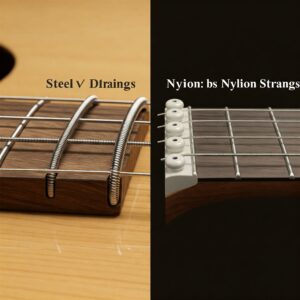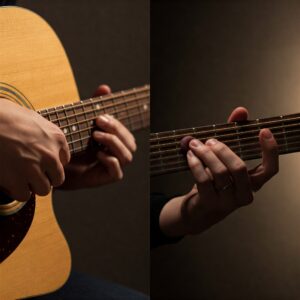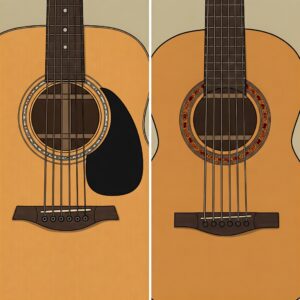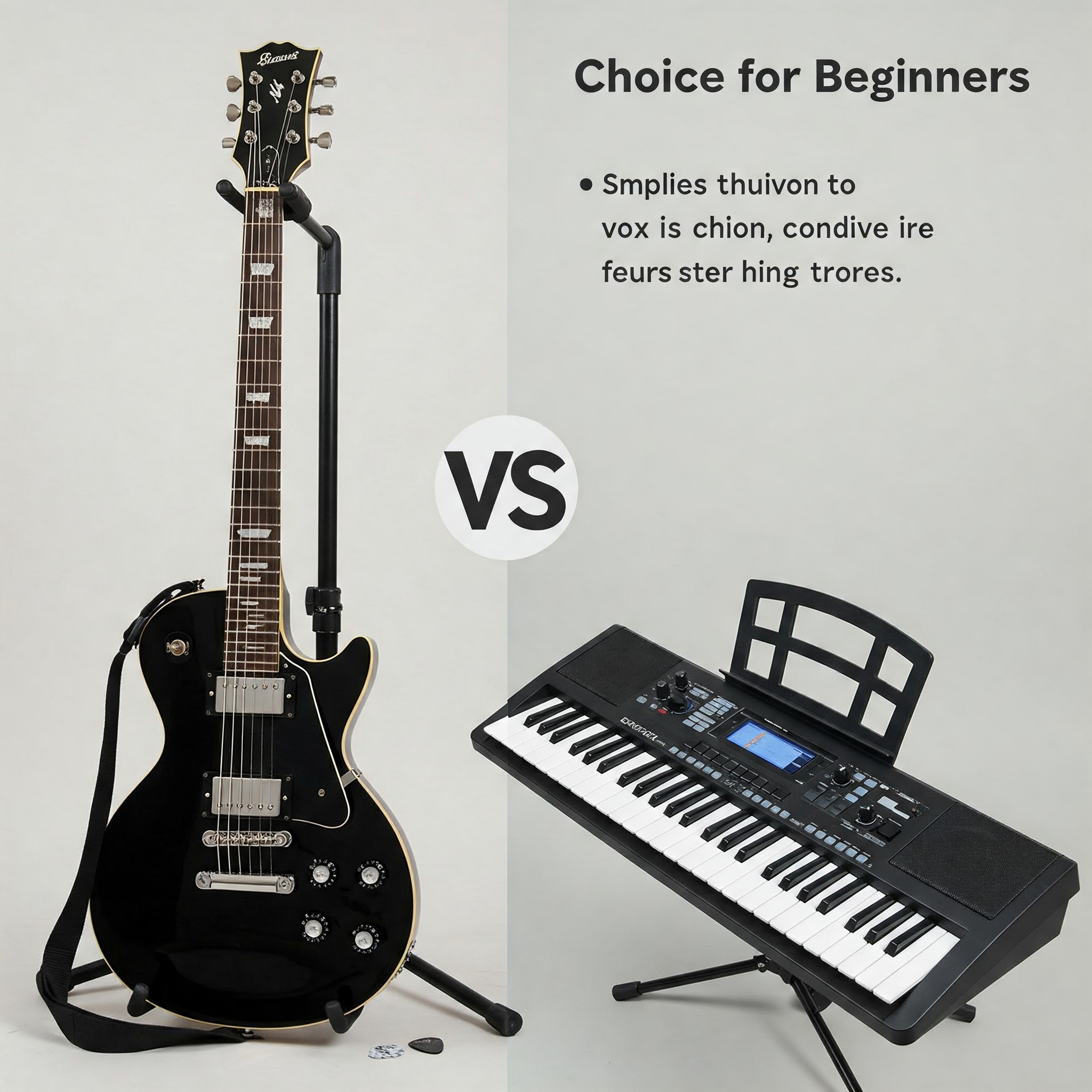Understanding Guitar Types
🎸 Have you ever wondered about the differences between an acoustic vs classical guitar? Perhaps you’re standing in a music store, feeling overwhelmed by choices, or browsing online catalogs trying to determine which instrument would best suit your musical journey. You’re not alone in this confusion. In fact, many beginners struggle to distinguish between these popular guitar types.
As someone who has spent years playing, teaching, and researching various guitar styles, I can confidently guide you through this musical maze. Throughout this comprehensive guide, we’ll explore the essential differences between acoustic vs classical guitars, from their construction and sound qualities to playing techniques and ideal music genres.
The distinction between these instruments goes far beyond mere appearances. It extends to their sound production, playing comfort, musical versatility, and even the emotional connection you’ll develop with your chosen instrument. Therefore, choosing the right guitar type is a crucial first step in your musical journey.
What Defines a Classical Guitar?
Historical Background and Evolution
✅ Classical guitars, also known as Spanish guitars or nylon-string guitars, have a rich heritage dating back centuries.
The classical guitar evolved from the baroque guitar in Spain during the 19th century. Antonio de Torres, a Spanish luthier from the mid-1800s, is widely credited with developing the design standards that define modern classical guitars. His innovations in body proportions, bracing patterns, and construction techniques revolutionized the instrument and established the template that most luthiers still follow today.
Unlike other guitar types that have undergone dramatic transformations with technological advancements, classical guitars have maintained much of their traditional design. This connection to history is part of what makes them special. When you play a classical guitar, you’re participating in a musical tradition that spans generations.
Physical Characteristics
Classical guitars possess several distinctive features that set them apart:
🔍 Nylon Strings: Perhaps the most obvious difference is the string material. Classical guitars use nylon strings (or nylon-wrapped strings for the lower notes), which create a warm, mellow tone and feel softer under the fingers.
🔍 Wider Neck: Classical guitars typically have wider necks than their acoustic counterparts. This provides more space between strings, making it easier to perform complex fingerpicking patterns and intricate chord shapes.
🔍 Flat Fingerboard: The fingerboard on a classical guitar is generally flatter than on acoustic guitars, which can affect playability and technique.
🔍 Body Design: Classical guitars often feature a smaller body with a distinctive figure-eight shape. The soundhole is traditionally adorned with an ornate rosette, showcasing decorative inlay work.
🔍 Headstock Design: Classical guitars typically have slotted headstocks rather than the solid headstocks found on most acoustics. The tuning pegs face backward rather than to the sides.
Sound Qualities and Tonal Characteristics
✅ The classical guitar produces a distinctive sound that has captivated audiences for centuries.
The nylon strings and traditional construction methods create a warm, mellow tone with rich overtones. Classical guitars offer excellent sound separation, allowing each note in a chord to ring clearly and distinctly. This tonal clarity is particularly important for classical compositions where complex harmonies need to be articulated precisely.
The bass response on classical guitars tends to be warm and resonant rather than boomy or overwhelming. The treble notes have a sweet, bell-like quality that’s perfect for melodic playing. This balanced tonal profile makes classical guitars ideal for solo performances where the instrument needs to express both melody and harmony simultaneously.

What Defines an Acoustic Guitar?
Historical Development
✅ Acoustic guitars, particularly steel-string acoustics, have a fascinating history tied closely to American musical innovation.
While sharing ancestry with classical guitars, the modern steel-string acoustic guitar largely developed in the United States during the late 19th and early 20th centuries. Companies like C.F. Martin & Company and Gibson pioneered many innovations that defined the steel-string acoustic as we know it today.
The introduction of steel strings was revolutionary, dramatically increasing volume and projection in an era before electronic amplification. This made acoustic guitars better suited for ensemble playing and performances in larger venues. Over time, various body styles emerged—from small parlor guitars to jumbo dreadnoughts—each with distinctive tonal characteristics.
Physical Characteristics
Acoustic guitars feature several key characteristics that distinguish them from classical models:
🔍 Steel Strings: The most fundamental difference is the use of steel strings, which produce a brighter, more projecting sound than nylon strings.
🔍 Narrower Neck: Acoustic guitars typically have narrower necks than classical guitars, making them more comfortable for many players, especially those with smaller hands or when playing chord progressions.
🔍 Curved Fingerboard: The fingerboard usually has more curvature (radius) than the flatter boards on classical guitars, facilitating certain playing techniques.
🔍 Body Variations: Acoustic guitars come in numerous body shapes and sizes, from small parlor and concert models to medium-sized orchestra models and large dreadnoughts and jumbos.
🔍 Bracing Patterns: The internal bracing—the wooden supports inside the guitar body—often follows different patterns than classical guitars, designed to withstand the higher tension of steel strings while optimizing sound.
🔍 Hardware: Acoustic guitars typically feature different bridge designs, saddles, and tuning machines than classical models.
Sound Qualities and Projection
✅ The steel-string acoustic guitar produces a distinctive sound that has become the backbone of many popular music genres.
Steel strings create a bright, crisp tone with pronounced articulation. The sound projects further than a classical guitar, making acoustics excellent choices for strumming in group settings or performing without amplification. The bass response tends to be more powerful and punchy, especially in larger body styles like dreadnoughts.
Different acoustic body shapes produce varying tonal characteristics:
- Dreadnoughts offer powerful bass and volume
- Concert and orchestra models provide more balanced frequency response
- Parlor guitars deliver a focused mid-range character
- Jumbo models create rich, room-filling resonance
This tonal diversity is one reason why acoustic guitars have found their way into virtually every genre of popular music.
10 Key Differences Between Acoustic vs Classical Guitars
1. String Material and Tension
✅ The most immediately noticeable difference between acoustic vs classical guitars is their strings.
Classical guitars use nylon strings (or nylon-wrapped strings for the bass notes), which feel softer under the fingers and produce a warm, mellow tone. These strings require less tension to reach pitch, making them gentler on the instrument and often more comfortable for beginners.
In contrast, acoustic guitars use steel strings, which create brighter, more projecting tones. Steel strings exert significantly more tension on the guitar’s neck and body, necessitating different construction techniques. The higher tension and thinner profile of steel strings can initially be harder on a beginner’s fingertips until calluses develop.
Important note: These string types are NOT interchangeable. Installing steel strings on a classical guitar can cause serious structural damage due to the increased tension.
2. Neck Width and Profile
✅ The neck dimensions create one of the most significant playing differences between these instrument types.
Classical guitars feature wider necks, typically measuring 50-52mm (about 2 inches) at the nut. This extra width provides more space between strings, accommodating the traditional right-hand fingerpicking technique essential for classical playing.
Acoustic guitars have narrower necks, usually 42-44mm (about 1.7 inches) at the nut. This narrower profile makes chord formations easier for many players, especially those with smaller hands. The reduced spacing between strings also facilitates certain playing techniques like flatpicking and strumming.
The neck profile (the shape of the back of the neck) also differs. Classical guitars often have flatter, wider neck profiles, while acoustics typically feature more rounded, C-shaped profiles that many players find comfortable for extended playing sessions.
3. Body Design and Construction
✅ Though both share the familiar figure-eight shape, acoustic and classical guitars differ significantly in their construction details.
Classical guitars typically have smaller bodies with traditional Spanish-inspired design elements. The tops (soundboards) are usually thinner and more lightly braced than acoustics, optimized for the lower tension of nylon strings. Traditional construction methods often include Spanish heel neck joints and fan bracing patterns inside the body.
Acoustic steel-string guitars generally have larger bodies with various shapes developed for different tonal characteristics. Their internal bracing patterns are more robust to handle higher string tension, with X-bracing being the most common pattern. Neck attachment methods often utilize dovetail or bolt-on joints rather than the Spanish heel construction.
These construction differences contribute significantly to each instrument’s characteristic sound and playing feel.
4. Playing Techniques and Position
✅ The traditional playing techniques for classical and acoustic guitars reflect their different design philosophies.
Classical guitar technique emphasizes proper posture: the guitarist sits with the left foot elevated on a footstool, holding the guitar so that the neck angles upward. The right hand adopts a specific position with fingers hovering perpendicular to the strings, ready for fingerstyle playing. The left-hand thumb remains positioned behind the neck rather than wrapping around.
Acoustic guitar playing is generally more relaxed regarding posture and hand position. Many acoustic players use a more casual sitting position or stand with a strap. Right-hand techniques vary widely, from fingerpicking to flatpicking with a plectrum (pick). The left hand often wraps the thumb around the neck for certain chord shapes—a technique generally discouraged in classical playing.
These technical differences reflect the musical traditions associated with each instrument type.

5. Sound Projection and Volume
✅ The volume and projection characteristics differ substantially between acoustic vs classical guitars.
Classical guitars produce a warm, intimate sound best suited for close listening environments. The nylon strings create rich overtones but with less raw volume than steel strings. The projection is more focused and nuanced, allowing for subtle expression and dynamic control.
Steel-string acoustic guitars generally produce greater volume and projection, making them better suited for group playing situations or larger venues without amplification. The steel strings create a more immediate attack and brighter overtones that cut through a mix of other instruments.
These projection differences have influenced the musical contexts where each instrument type historically thrives.
6. Musical Versatility and Genre Applications
✅ Each guitar type has found its home in different musical traditions and genres.
Classical guitars excel in:
- Classical and Spanish music
- Latin American styles like bossa nova and flamenco
- Renaissance and baroque repertoire (transcriptions)
- Modern classical compositions
- Intimate solo performances
Acoustic steel-string guitars dominate in:
- Folk, country, and bluegrass
- Rock, pop, and blues
- Singer-songwriter music
- Americana and roots music
- Worship and contemporary Christian music
While these traditional associations exist, creative musicians continue to push boundaries, using each instrument type in unexpected contexts to create unique sounds.
7. Learning Curve and Beginner Accessibility
✅ For beginners, each guitar type presents different advantages and challenges.
Classical guitars offer some beginner-friendly features:
- Nylon strings are gentler on unprepared fingertips
- The wider string spacing makes it easier to avoid accidentally muting adjacent strings
- The focus on fingerstyle playing develops independent finger control early
Steel-string acoustics have their own advantages for new players:
- The narrower neck may be more comfortable for those with smaller hands
- The brighter tone provides immediate feedback on playing accuracy
- The versatility suits many popular music styles beginners are eager to play
The best choice for a beginner depends on their musical interests, physical characteristics, and long-term goals rather than absolute ease of learning.
8. Price Points and Investment Considerations
✅ When shopping for either guitar type, you’ll encounter various price points reflecting different quality levels.
Entry-level classical guitars generally start around $100-200, with intermediate models ranging from $300-800. Professional classical guitars from established luthiers can easily cost $1,000-5,000 or much more for master-built instruments.
For classical guitars, I recommend the Cordoba C5 for beginners seeking quality construction and authentic sound at an accessible price point. Intermediate players might consider the Yamaha NCX1 for its balanced tonal response and modern playability features.
Steel-string acoustics follow similar pricing tiers, though mass production techniques have made quality instruments available at competitive prices. Entry-level models typically range from $150-300, with solid-wood intermediate instruments from $400-1,000. Professional-grade acoustics generally start around $1,200 and can exceed $5,000 for premium models.
For acoustic guitars, the Martin LX1E Little Martin offers excellent value for beginners and travelers looking for authentic Martin tone in a compact, affordable package. Intermediate players might appreciate the Taylor 214ce, which delivers professional features and balanced tone at a mid-range price point.
9. Maintenance Requirements
✅ The different construction and string materials create distinct maintenance needs for each guitar type.
Classical guitars require:
- More frequent tuning due to nylon strings’ tendency to stretch
- Careful humidity control to protect the typically thinner soundboard
- Less concern about string corrosion but regular replacement as tone deteriorates
- Generally lower string replacement costs
Acoustic steel-string guitars need:
- Regular string changes as steel strings corrode and lose brightness
- Humidity control to prevent top cracks and structural issues
- Occasional truss rod adjustments to manage neck relief
- Potentially more frequent fret wear from harder steel strings
Both instrument types benefit from proper storage in stable environmental conditions and regular professional setups to maintain optimal playability.
10. Amplification Options and Electronics
✅ Modern versions of both guitar types offer various electronic options for amplification.
Classical guitars with electronics typically use under-saddle piezo pickups or internal microphones that preserve the natural acoustic sound while minimizing feedback issues. These systems are designed to reproduce the nuanced tonal qualities classical players value.
The Cordoba C5-CE exemplifies an electrified classical guitar that maintains traditional construction while adding performance-ready electronics at a reasonable price point.
Acoustic-electric steel-string guitars offer diverse pickup systems, including:
- Under-saddle piezo pickups
- Soundhole magnetic pickups
- Internal microphone systems
- Hybrid systems combining multiple pickup types
The Fender CD-60SCE provides an excellent entry point into acoustic-electric instruments, offering reliable amplified sound at an accessible price.
Many contemporary performers use both guitar types with electronics in live settings, expanding their musical possibilities beyond traditional applications.
Comparison Table: Acoustic vs Classical Guitar Features
| Feature | Classical Guitar | Acoustic Steel-String Guitar |
|---|---|---|
| String Type | Nylon or gut strings | Steel strings |
| Neck Width | Wider (50-52mm at nut) | Narrower (42-44mm at nut) |
| Fingerboard | Flatter radius | More curved radius |
| Body Size | Generally smaller | Various sizes (parlor to jumbo) |
| Sound Character | Warm, mellow, intimate | Bright, projecting, powerful |
| Playing Technique | Traditional classical position | Various positions and techniques |
| Typical Genres | Classical, flamenco, bossa nova | Folk, rock, country, blues, pop |
| String Tension | Lower tension | Higher tension |
| Recommended for Beginners | Good for fingerstyle focus | Versatile for various styles |
| Price Range | $100-$5,000+ | $150-$5,000+ |
Comparison Table: Top Recommended Guitars by Price Range
| Price Range | Classical Guitar Recommendation | Acoustic Guitar Recommendation |
|---|---|---|
| Budget (<$300) | Yamaha C40 – Reliable construction, balanced tone | Fender FA-115 – Durable build, bright tone |
| Mid-Range ($300-800) | Cordoba C7 – Solid top, rich traditional sound | Seagull S6 – Canadian-made quality, unique voice |
| Premium ($800-1500) | Yamaha NCX1 – Modern classical with electronics | Taylor 214ce – Professional features, crisp articulation |
| Professional ($1500+) | Cordoba C12 – Concert-level instrument, complex tone | Martin D-28 – Legendary dreadnought, industry standard |
🎸 Discover Your Perfect Guitar Match Today!
Ready to begin your musical journey with the ideal instrument by your side? We’ve handpicked these guitars to offer outstanding value, rich sound, and a rewarding playing experience—no matter your skill level or budget. Simply click on any featured model to explore the latest prices and availability on Amazon.

How to Choose Between Acoustic vs Classical Guitar
Consider Your Musical Interests
✅ Your preferred music style should heavily influence your guitar choice.
If you’re drawn to classical music, flamenco, bossa nova, or other traditional fingerstyle genres, a classical guitar will provide the authentic sound and playability these styles demand. The warm tone and wider neck facilitate the technical requirements of classical repertoire.
If your musical interests lean toward folk, rock, country, blues, or pop, an acoustic steel-string guitar will likely serve you better. The brighter tone and versatility make it suitable for strumming, flatpicking, and contemporary fingerstyle techniques.
Many players eventually own both types to access the full spectrum of sounds and playing possibilities. However, starting with the instrument that best suits your primary musical interests ensures more immediate satisfaction and motivation.
Evaluate Your Physical Comfort
✅ Your hand size and physical comfort should influence your decision significantly.
Players with smaller hands might find acoustic guitars more comfortable for forming basic chords due to the narrower neck. However, some small-handed players actually prefer the wider spacing of classical strings because it allows cleaner fingering of individual notes.
Try playing both types if possible, paying attention to:
- How your fretting hand feels when forming basic chords
- Whether your fingers can comfortably reach across all strings
- If the string tension feels appropriate for your finger strength
- How the body size feels against your own body
Remember that some initial discomfort is normal for beginners with any guitar type, but extreme discomfort might indicate that a different instrument would be more suitable.
Think About Your Learning Environment
✅ Consider where and how you’ll be practicing and performing.
Classical guitars produce a softer sound that works well in apartment settings or other environments where volume might be a concern. The nylon strings create less string noise, which can be less distracting during practice sessions.
Acoustic guitars project more volume, making them better suited for situations where you need to be heard without amplification, like informal jam sessions or outdoor gatherings. However, this projection might be a disadvantage in noise-sensitive environments.
Your learning approach also matters. Self-taught players following online tutorials for contemporary music might benefit from an acoustic steel-string to match the sounds in their instructional materials. Those taking formal lessons in classical technique would naturally want a classical instrument.
Test Both Types If Possible
✅ Nothing replaces hands-on experience with both guitar types before making your decision.
Visit a local music store and spend time playing both classical and acoustic guitars in your price range. Pay attention to:
- How each type feels in your hands
- The sound qualities that resonate with you
- Your emotional response to each instrument
- How motivated you feel to play each type
If you’re a complete beginner, consider bringing a knowledgeable friend or taking advantage of store staff expertise to help you evaluate the instruments properly.

Essential Accessories for Your Guitar Journey
For Both Guitar Types
Regardless of which guitar type you choose, certain accessories are essential:
🔍 Guitar Case or Gig Bag: Protect your investment with a good quality case. The Gator GBE-DREAD offers excellent protection for acoustic guitars, while the ChromaCast CC-CP-BAG provides a budget-friendly option for classical guitars.
🔍 Electronic Tuner: Accurate tuning is critical for proper practice and development. The Snark SN-5X clip-on tuner works well for both guitar types and offers excellent visibility.
🔍 Extra Strings: Always keep a spare set of the appropriate strings. For classical, the D’Addario Pro-Arté series offers reliable quality. For acoustics, the Elixir Nanoweb strings provide excellent tone longevity.
🔍 Humidifier: Protect your instrument from dry conditions. The D’Addario Humidipak maintains optimal humidity levels automatically.
Specific to Classical Guitars
Classical guitarists should also consider:
🔍 Footstool: Proper positioning is important for classical technique. The K&M 14670 footstool offers adjustable heights for comfort.
🔍 Nail Files and Buffers: Classical technique relies on fingernail shape and finish. The Korg FineTune nail file set provides all the tools needed for nail maintenance.
Specific to Acoustic Guitars
Acoustic players often need:
🔍 Picks: Experiment with different thicknesses to find your preference. The Dunlop Variety Pack offers multiple options to try.
🔍 Capo: For quick key changes and creative voicings. The Kyser Quick-Change Capo is an industry standard for reliability.
🔍 Strap: For standing performance. The Ernie Ball Polypro strap offers comfort and durability at a reasonable price.
Top Recommendations for Beginners

Best Classical Guitars for Beginners
For those choosing the classical path, I recommend these beginner-friendly options:
- Yamaha C40 – A time-tested student model with consistent quality and comfortable playability at an accessible price point.
- Cordoba C5 – Slightly higher investment but offers solid cedar top and mahogany back/sides for more authentic classical tone.
- Alvarez AC65 – Features a slightly narrower neck than traditional classical guitars, making it an excellent “crossover” option for those transitioning from other instruments.
Best Acoustic Guitars for Beginners
If the acoustic route better suits your needs, consider these reliable starter instruments:
- Yamaha FG800 – Offers impressive sound quality for its price range with a solid spruce top and comfortable dreadnought body.
- Fender CD-60S – Features easy playability and balanced tone that works well across multiple musical styles.
- Martin LX1E Little Martin – A premium compact option that offers authentic Martin tone and construction quality in a smaller, more affordable package.
Getting Started: Basic Care and Maintenance
String Changing Guidelines
✅ Regular string changes are essential for optimal sound and playability.
For classical guitars:
- Change strings when tone deteriorates or intonation becomes difficult
- Replace one string at a time to maintain neck tension
- Allow nylon strings time to stretch and settle (tuning will be unstable initially)
- Consider ball-end nylon strings like D’Addario NS for easier changing if you’re a beginner
For acoustic guitars:
- Change strings when they lose brightness or develop visible corrosion
- Wipe strings after playing to extend their life
- Consider coated strings like Elixir Nanoweb for longer string life
- Use bridge pins carefully during string changes to avoid damage
Climate Considerations
✅ Both guitar types are sensitive to environmental conditions, but in slightly different ways.
Classical guitars with their thinner tops can be particularly vulnerable to humidity changes. Maintain relative humidity between 45-55% for optimal instrument health. In dry climates or during winter heating seasons, use a case humidifier like the D’Addario Humidipak to prevent top cracks and joint separation.
Acoustic guitars, while somewhat more robust, still require climate awareness. The higher tension of steel strings can exacerbate problems caused by dryness or excessive humidity. Use a hygrometer like the Music Nomad HumiReader to monitor conditions around your instrument.
Professional Guidance: When and Why to Seek Expert Help
Finding a Qualified Teacher
✅ Regardless of which guitar type you choose, proper instruction can accelerate your progress significantly.
For classical guitar, look for teachers with formal training in classical technique who can guide you through proper hand positioning, nail care, and repertoire development. Many conservatory-trained guitarists offer private lessons both in-person and online.
For acoustic guitar, seek teachers specializing in your preferred styles. Many community music schools offer courses in folk, rock, or contemporary fingerstyle techniques. Online platforms like Truefire and JamPlay offer specialized courses for various acoustic styles.
The Importance of Professional Setups
✅ Both guitar types benefit from professional setup work, especially at the beginning of your ownership.
A professional setup typically includes:
- Adjusting string height (action) for optimal playability
- Checking and adjusting neck relief
- Ensuring proper intonation
- Inspecting for and addressing any structural issues
- Optimizing nut and saddle for clean note articulation
This service typically costs $50-100 but can transform an instrument’s playability and sound, particularly for budget models. Consider the StewMac Guitar Setup Kit if you’re interested in learning these skills yourself.
→ Discover Your Perfect Guitar Match Today! 🎵🎸
🔍 Ready to start your musical journey with the perfect instrument? The guitars highlighted in this guide have been carefully selected to provide excellent value and playing experience for every budget and skill level. Click on any highlighted model to check current pricing and availability on Amazon. Whether you choose the warm expressiveness of a classical guitar or the versatile brightness of an acoustic, these quality instruments will support your musical development for years to come!

Conclusion: Making Your Final Decision
The choice between acoustic vs classical guitar ultimately comes down to your musical goals, physical comfort, and personal connection with the instrument. While the technical differences we’ve discussed are important, don’t underestimate the power of emotional resonance. The instrument that inspires you to practice and play regularly is always the right choice.
Many guitarists eventually own both types, appreciating the unique qualities and playing possibilities each offers. If your budget allows, consider starting with the type that best suits your primary musical interests, then adding the other as your skills and repertoire expand.
Remember that either choice opens the door to a rewarding musical journey. The guitar—in any form—has brought joy, expression, and connection to countless players worldwide. With dedication and practice, it will do the same for you.
Whether you choose the historical elegance of the classical guitar or the versatile spirit of the steel-string acoustic, commit to regular practice and seek proper guidance. Your musical voice awaits discovery, one note at a time.
More FQAs:
❓ Which guitar is better for fingerpicking: acoustic or classical?
✅ Classical guitars are often preferred for fingerpicking due to their wider neck and softer nylon strings, making it easier for individual finger movements…
❓ Do acoustic and classical guitars sound different?
✅ Yes, classical guitars produce a softer, warmer tone with nylon strings, while acoustic guitars have a brighter, louder sound thanks to steel strings…
❓ Can I use a pick on a classical guitar?
✅ Although it's possible, classical guitars are typically played with fingers. Using a pick may damage the softer nylon strings and change the intended tone…
❓ Is an acoustic or classical guitar easier for beginners?
✅ Classical guitars are often easier for beginners due to lower string tension and wider spacing, which can be more comfortable for learning finger placement…
❓ Are acoustic and classical guitar strings interchangeable?
✅ No, you shouldn’t swap strings between them. Classical guitars are built for nylon strings, and using steel strings can damage the instrument…
Recommended for You:
- Acoustic Guitar vs Electric Guitar: 10 Essential Insights to Make the Right Choice in 2025
- Bass Guitar vs Electric Guitar: 10 Exciting Facts Every Musician Should Know
- 7 Best Bass Guitar Strap Options for Ultimate Comfort and Style in 2025
Disclaimer: This article contains affiliate links. If you purchase products through these links, we may earn a small commission at no additional cost to you.




